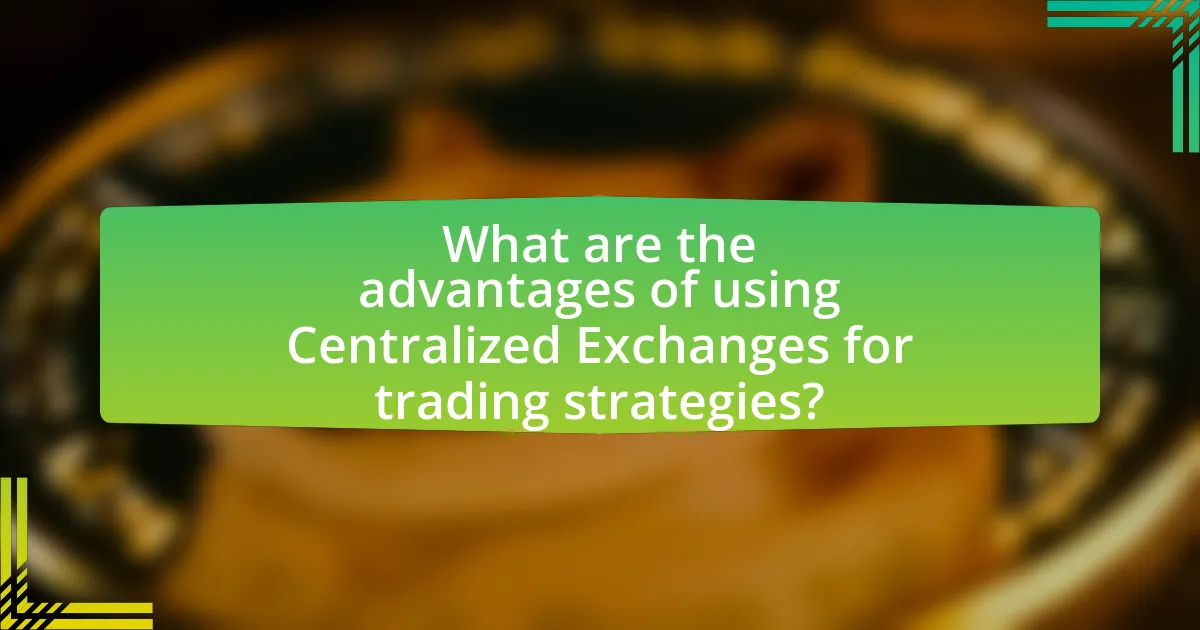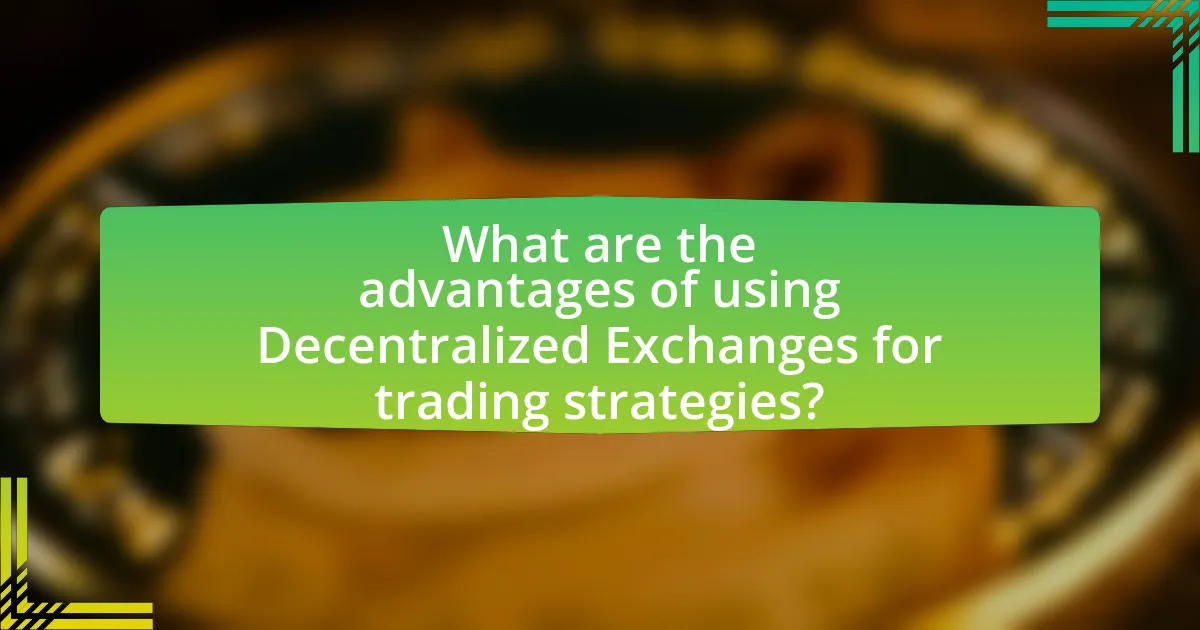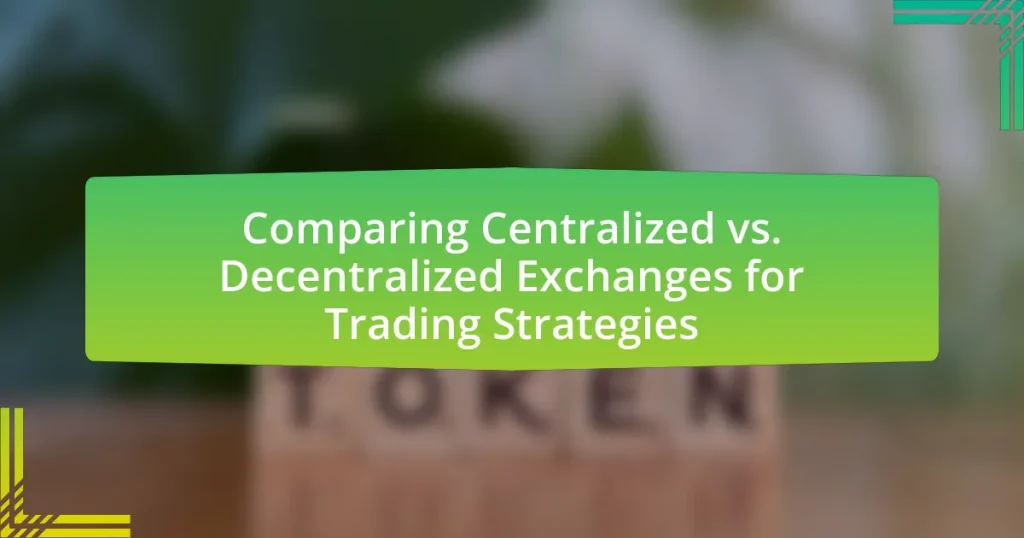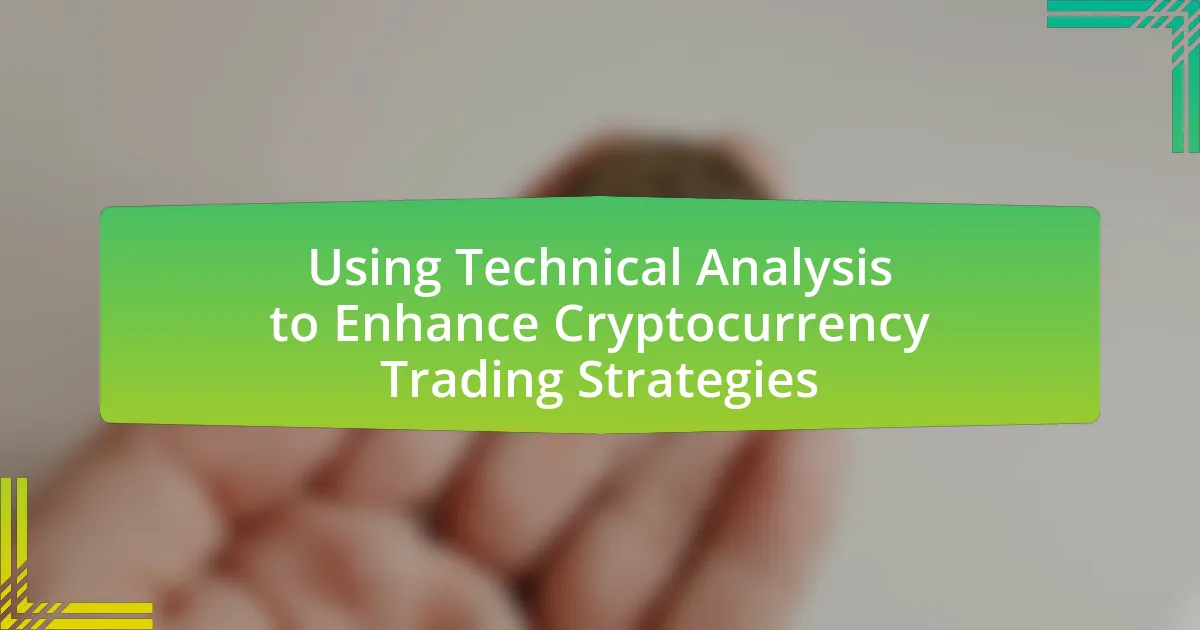The article focuses on comparing centralized and decentralized exchanges (CEXs and DEXs) for trading strategies in the cryptocurrency market. It outlines the operational mechanisms of both types of exchanges, highlighting key features such as liquidity, transaction speeds, security measures, and user experience. Centralized exchanges are characterized by their role as intermediaries, offering higher liquidity and faster transactions, while decentralized exchanges facilitate peer-to-peer trading, providing enhanced privacy and control over funds. The article also discusses the advantages and drawbacks of each exchange type, including trading fees, regulatory compliance, and the impact on trading strategies, enabling traders to make informed decisions based on their specific needs and risk tolerance.

What are Centralized and Decentralized Exchanges?
Centralized exchanges are platforms where transactions are facilitated by a central authority or organization, which manages the order book and holds users’ funds. In contrast, decentralized exchanges operate without a central authority, allowing users to trade directly with one another through smart contracts on a blockchain. Centralized exchanges, such as Binance and Coinbase, typically offer higher liquidity and faster transaction speeds, while decentralized exchanges, like Uniswap and SushiSwap, provide greater privacy and control over funds. The distinction is significant as it influences trading strategies, with centralized exchanges often appealing to users seeking convenience and speed, while decentralized exchanges attract those prioritizing security and autonomy.
How do Centralized Exchanges operate?
Centralized exchanges operate by acting as intermediaries between buyers and sellers of cryptocurrencies. They facilitate trading by matching orders from users on their platform, maintaining an order book that records all buy and sell orders. Users deposit their funds into the exchange, which holds the assets in custodial wallets, allowing for quick transactions and liquidity. Centralized exchanges typically charge fees for trades and may offer additional services such as margin trading and advanced trading tools. The operation of these exchanges is governed by regulatory frameworks, which can vary by jurisdiction, ensuring a level of oversight and security for users.
What are the key features of Centralized Exchanges?
Centralized exchanges are platforms that facilitate the buying and selling of cryptocurrencies through a centralized authority. Key features include user-friendly interfaces, high liquidity, and robust security measures. User-friendly interfaces allow traders to easily navigate the platform, while high liquidity ensures that users can execute trades quickly without significant price fluctuations. Additionally, centralized exchanges often implement advanced security protocols, such as two-factor authentication and cold storage for funds, to protect users’ assets. These features make centralized exchanges popular among both novice and experienced traders.
What security measures are in place for Centralized Exchanges?
Centralized exchanges implement several security measures to protect user assets and data. These measures include two-factor authentication (2FA), which requires users to provide a second form of verification in addition to their password, significantly reducing unauthorized access. Additionally, centralized exchanges often utilize cold storage for the majority of their digital assets, keeping them offline and away from potential cyber threats. Regular security audits and penetration testing are conducted to identify and rectify vulnerabilities, ensuring the platform’s resilience against attacks. Furthermore, many exchanges have insurance policies in place to cover potential losses from breaches, providing an extra layer of security for users. These practices collectively enhance the overall security framework of centralized exchanges, making them more robust against various threats.
How do Decentralized Exchanges operate?
Decentralized exchanges operate by enabling peer-to-peer trading of cryptocurrencies without the need for an intermediary. These platforms utilize smart contracts on blockchain technology to facilitate transactions directly between users, ensuring that trades are executed automatically when predefined conditions are met. For instance, platforms like Uniswap and SushiSwap leverage automated market makers (AMMs) to provide liquidity and price determination based on supply and demand dynamics, rather than relying on order books typical of centralized exchanges. This model enhances security and privacy, as users retain control of their funds throughout the trading process, reducing the risk of hacks associated with centralized custodial services.
What are the key features of Decentralized Exchanges?
Decentralized exchanges (DEXs) are platforms that facilitate peer-to-peer trading of cryptocurrencies without the need for an intermediary. Key features of DEXs include enhanced privacy, as users retain control of their private keys and personal information; increased security, since funds are not held in a central location vulnerable to hacks; and greater accessibility, allowing anyone with an internet connection to trade without the need for a traditional account setup. Additionally, DEXs often utilize smart contracts to automate transactions, ensuring transparency and reducing the risk of fraud. According to a report by CoinGecko, the trading volume on DEXs has surged, indicating a growing preference for these platforms among users seeking autonomy and security in their trading activities.
What security measures are in place for Decentralized Exchanges?
Decentralized exchanges implement several security measures to protect users and their assets. These measures include smart contract audits, which ensure that the code governing transactions is secure and free from vulnerabilities; multi-signature wallets, which require multiple approvals for transactions, reducing the risk of unauthorized access; and decentralized custody, where users retain control of their private keys, minimizing the risk of hacks associated with centralized storage. Additionally, many decentralized exchanges utilize liquidity pools and automated market makers, which enhance security by reducing reliance on a single point of failure. These practices collectively contribute to a more secure trading environment compared to centralized exchanges, where user funds are often held in a single location, making them more susceptible to attacks.
What are the main differences between Centralized and Decentralized Exchanges?
Centralized exchanges (CEXs) are platforms where transactions are facilitated by a central authority, while decentralized exchanges (DEXs) operate without a central authority, allowing peer-to-peer trading. CEXs typically offer higher liquidity and faster transaction speeds due to their centralized nature, which can lead to better price discovery. In contrast, DEXs provide users with greater control over their funds and enhanced privacy, as they do not require users to deposit assets into the exchange. Additionally, CEXs often have regulatory compliance measures, whereas DEXs may operate in a more anonymous and less regulated environment. These fundamental differences impact trading strategies, with CEXs being more suitable for high-frequency trading and DEXs appealing to those prioritizing security and privacy.
How do trading fees compare between Centralized and Decentralized Exchanges?
Trading fees on Centralized Exchanges (CEXs) are generally higher than those on Decentralized Exchanges (DEXs). CEXs typically charge fees ranging from 0.1% to 0.5% per trade, while DEXs often have lower fees, sometimes as low as 0.03% to 0.1%. This difference is primarily due to the operational costs associated with CEXs, which include maintaining a centralized infrastructure and regulatory compliance. In contrast, DEXs leverage smart contracts and do not require intermediaries, resulting in reduced costs and lower fees for users.
What are the liquidity differences between Centralized and Decentralized Exchanges?
Centralized exchanges typically offer higher liquidity compared to decentralized exchanges. This is due to centralized exchanges aggregating a larger number of buyers and sellers on a single platform, which facilitates quicker transactions and tighter spreads. For instance, as of 2023, major centralized exchanges like Binance and Coinbase have reported daily trading volumes exceeding $1 billion, indicating robust liquidity. In contrast, decentralized exchanges, while growing in popularity, often experience lower liquidity because they rely on individual users to provide liquidity through liquidity pools, which can lead to wider spreads and slippage during trades. For example, Uniswap, a leading decentralized exchange, has seen varying liquidity levels, often dependent on the specific trading pair and market conditions.

What are the advantages of using Centralized Exchanges for trading strategies?
Centralized exchanges offer several advantages for trading strategies, primarily including higher liquidity, faster transaction speeds, and user-friendly interfaces. Higher liquidity on centralized exchanges, such as Binance or Coinbase, allows traders to execute large orders without significantly impacting market prices, which is crucial for effective trading strategies. Additionally, centralized exchanges typically process transactions more quickly than decentralized counterparts, enabling traders to capitalize on market movements in real-time. User-friendly interfaces and comprehensive trading tools provided by centralized exchanges simplify the trading process, making them accessible for both novice and experienced traders. These factors collectively enhance the efficiency and effectiveness of trading strategies employed on centralized platforms.
Why might traders prefer Centralized Exchanges?
Traders might prefer Centralized Exchanges due to their higher liquidity and user-friendly interfaces. Centralized Exchanges typically facilitate a larger volume of trades, which allows for quicker transactions and better price stability. For instance, platforms like Binance and Coinbase have millions of active users, resulting in significant liquidity that can minimize slippage during trades. Additionally, these exchanges often provide advanced trading tools and customer support, making them more accessible for both novice and experienced traders.
What benefits do Centralized Exchanges offer in terms of user experience?
Centralized exchanges offer several benefits in terms of user experience, including enhanced liquidity, user-friendly interfaces, and faster transaction speeds. Enhanced liquidity allows users to execute trades quickly and at competitive prices due to the large volume of transactions processed on these platforms. User-friendly interfaces simplify the trading process, making it accessible even for beginners, as many centralized exchanges provide educational resources and customer support. Additionally, faster transaction speeds ensure that trades are executed promptly, which is crucial for users looking to capitalize on market fluctuations. These factors collectively contribute to a more efficient and satisfying trading experience for users on centralized exchanges.
How do Centralized Exchanges enhance trading speed and efficiency?
Centralized exchanges enhance trading speed and efficiency by utilizing advanced technology and infrastructure that facilitate rapid order execution and high liquidity. These platforms operate on centralized servers, allowing for faster transaction processing compared to decentralized exchanges, which rely on blockchain technology that can introduce delays. For instance, centralized exchanges can handle thousands of transactions per second due to their optimized order matching engines, significantly reducing latency. Additionally, the presence of high liquidity on these exchanges ensures that traders can execute large orders without substantial price slippage, further enhancing the overall trading experience.
What are the potential drawbacks of Centralized Exchanges?
Centralized exchanges have several potential drawbacks, including security risks, lack of control over funds, and regulatory issues. Security risks arise from the centralized nature of these platforms, making them attractive targets for hackers; for instance, major exchanges like Mt. Gox and Bitfinex have suffered significant breaches, resulting in the loss of millions of dollars. Users also lack control over their funds, as they must deposit assets into the exchange’s wallet, which can lead to loss of access if the exchange faces insolvency or operational issues. Additionally, centralized exchanges often face regulatory scrutiny, which can lead to sudden changes in service availability or compliance requirements, impacting users’ trading strategies.
What risks are associated with Centralized Exchanges?
Centralized exchanges pose several risks, including security vulnerabilities, regulatory scrutiny, and potential for market manipulation. Security breaches have historically led to significant losses; for instance, the Mt. Gox hack in 2014 resulted in the loss of approximately 850,000 Bitcoins, highlighting the susceptibility of centralized platforms to cyberattacks. Regulatory scrutiny can lead to sudden changes in operational legality, as seen in various countries imposing restrictions on exchanges, which can disrupt trading activities. Additionally, centralized exchanges can be subject to market manipulation due to their control over order books and trading processes, potentially disadvantaging users.
How do regulatory issues impact Centralized Exchanges?
Regulatory issues significantly impact Centralized Exchanges by imposing compliance requirements that can affect their operational costs and market accessibility. For instance, regulations such as the Financial Action Task Force (FATF) guidelines require exchanges to implement Know Your Customer (KYC) and Anti-Money Laundering (AML) protocols, which can increase operational expenses and limit user anonymity. Additionally, regulatory scrutiny can lead to the suspension of services or even closure of exchanges that fail to comply, as seen in the case of Bitfinex in 2016 when it faced regulatory challenges in New York. These factors can influence user trust and trading volume, ultimately shaping the competitive landscape of centralized trading platforms.

What are the advantages of using Decentralized Exchanges for trading strategies?
Decentralized exchanges (DEXs) offer several advantages for trading strategies, primarily including enhanced security, greater privacy, and reduced reliance on intermediaries. Security is improved as users retain control of their private keys, minimizing the risk of hacks that often target centralized exchanges. Greater privacy is achieved since DEXs typically do not require extensive personal information, allowing users to trade without revealing their identities. Additionally, reduced reliance on intermediaries leads to lower fees and faster transactions, as trades occur directly between users on the blockchain. These factors collectively create a more efficient and user-centric trading environment, making DEXs increasingly popular among traders.
Why might traders prefer Decentralized Exchanges?
Traders might prefer Decentralized Exchanges (DEXs) due to their enhanced privacy and control over funds. DEXs allow users to trade directly from their wallets without the need for an intermediary, reducing the risk of hacks associated with centralized platforms. According to a report by Chainalysis, decentralized finance (DeFi) platforms have seen significant growth, with DEX trading volume reaching over $200 billion in 2021, highlighting their increasing popularity among traders seeking autonomy and security.
What benefits do Decentralized Exchanges offer in terms of privacy and control?
Decentralized exchanges (DEXs) provide significant benefits in terms of privacy and control by allowing users to trade directly from their wallets without the need for intermediaries. This direct trading model enhances user privacy, as DEXs typically do not require personal information or extensive Know Your Customer (KYC) processes, unlike centralized exchanges that often mandate identity verification. Furthermore, users maintain full control over their funds and private keys, reducing the risk of hacks or mismanagement associated with centralized platforms. The absence of a central authority also means that users can trade freely without censorship or restrictions imposed by a governing body, thereby ensuring greater autonomy in their trading activities.
How do Decentralized Exchanges promote security and transparency?
Decentralized exchanges promote security and transparency by utilizing blockchain technology, which ensures that all transactions are recorded on a public ledger. This transparency allows users to verify transactions independently, reducing the risk of fraud. Additionally, decentralized exchanges do not require users to deposit funds into a central authority, minimizing the risk of hacks that often target centralized exchanges. According to a report by Chainalysis, decentralized exchanges experienced significantly fewer security breaches compared to their centralized counterparts, highlighting their inherent security advantages.
What are the potential drawbacks of Decentralized Exchanges?
Decentralized exchanges (DEXs) have several potential drawbacks, including lower liquidity, slower transaction speeds, and a lack of customer support. Lower liquidity can lead to higher price volatility and slippage, making it difficult for traders to execute large orders without significantly impacting the market price. Slower transaction speeds, compared to centralized exchanges, can hinder trading efficiency, especially during periods of high network congestion. Additionally, the absence of customer support can pose challenges for users who encounter issues, as DEXs typically operate without a centralized authority to assist with disputes or technical difficulties. These factors can limit the overall user experience and effectiveness of trading strategies on decentralized platforms.
What challenges do Decentralized Exchanges face regarding liquidity?
Decentralized Exchanges (DEXs) face significant challenges regarding liquidity, primarily due to lower trading volumes compared to Centralized Exchanges (CEXs). This disparity arises because DEXs often lack the market-making mechanisms that CEXs utilize to attract liquidity, resulting in wider spreads and slippage for traders. Additionally, the reliance on liquidity pools can lead to impermanent loss for liquidity providers, discouraging participation. According to a report by the Blockchain Research Institute, DEXs accounted for only 10% of total cryptocurrency trading volume in 2021, highlighting their liquidity challenges.
How does the user experience differ on Decentralized Exchanges?
User experience on decentralized exchanges (DEXs) differs significantly from centralized exchanges (CEXs) primarily due to the lack of intermediaries and the emphasis on user control. On DEXs, users retain full ownership of their assets, as trades occur directly between users through smart contracts, eliminating the need for a central authority to manage funds. This model enhances privacy and security, as users do not need to provide personal information or trust a third party with their assets.
Additionally, DEXs often feature a more complex user interface and require a greater understanding of blockchain technology, which can be a barrier for novice traders. Unlike CEXs, which typically offer customer support and user-friendly interfaces, DEXs may lack these services, leading to a steeper learning curve. Furthermore, transaction speeds and fees can vary widely on DEXs, influenced by network congestion and gas fees, which can impact the overall trading experience.
In summary, the user experience on decentralized exchanges is characterized by greater control and privacy but also presents challenges in usability and support compared to centralized exchanges.
How can traders choose between Centralized and Decentralized Exchanges for their strategies?
Traders can choose between Centralized and Decentralized Exchanges based on their specific trading needs, risk tolerance, and desired level of control. Centralized Exchanges, such as Binance and Coinbase, offer higher liquidity, faster transaction speeds, and user-friendly interfaces, making them suitable for traders seeking efficiency and ease of use. In contrast, Decentralized Exchanges, like Uniswap and SushiSwap, provide greater privacy, control over funds, and reduced reliance on third parties, appealing to those prioritizing security and autonomy.
The choice can also be influenced by factors such as regulatory compliance, as Centralized Exchanges often adhere to stricter regulations, while Decentralized Exchanges operate with more anonymity. Additionally, traders should consider transaction fees, as Centralized Exchanges may charge higher fees for services, whereas Decentralized Exchanges typically have lower fees but can incur gas costs depending on the blockchain used. Ultimately, the decision hinges on balancing the trade-offs between convenience, security, and control based on individual trading strategies.
What factors should traders consider when selecting an exchange type?
Traders should consider liquidity, security, fees, regulatory compliance, and user experience when selecting an exchange type. Liquidity is crucial as it affects the ease of executing trades without significant price changes; centralized exchanges typically offer higher liquidity due to larger user bases. Security is vital, with decentralized exchanges often providing greater control over funds, while centralized exchanges may be more susceptible to hacks. Fees vary significantly; centralized exchanges usually charge trading fees, while decentralized exchanges may have lower or no fees but can incur higher gas costs. Regulatory compliance is important as centralized exchanges often adhere to local laws, which can affect their operation and user trust. Lastly, user experience, including interface usability and customer support, can significantly impact trading efficiency and satisfaction.
How can traders effectively balance risks and rewards in their exchange choice?
Traders can effectively balance risks and rewards in their exchange choice by conducting thorough research on both centralized and decentralized exchanges, assessing factors such as security, fees, liquidity, and regulatory compliance. Centralized exchanges typically offer higher liquidity and faster transactions, but they also present risks like hacking and regulatory scrutiny, as evidenced by the 2014 Mt. Gox hack where approximately $450 million was lost. In contrast, decentralized exchanges provide greater control over funds and enhanced privacy, but they may have lower liquidity and higher transaction costs, as seen in the fluctuating trading volumes of platforms like Uniswap. By evaluating these aspects, traders can make informed decisions that align with their risk tolerance and investment goals.






